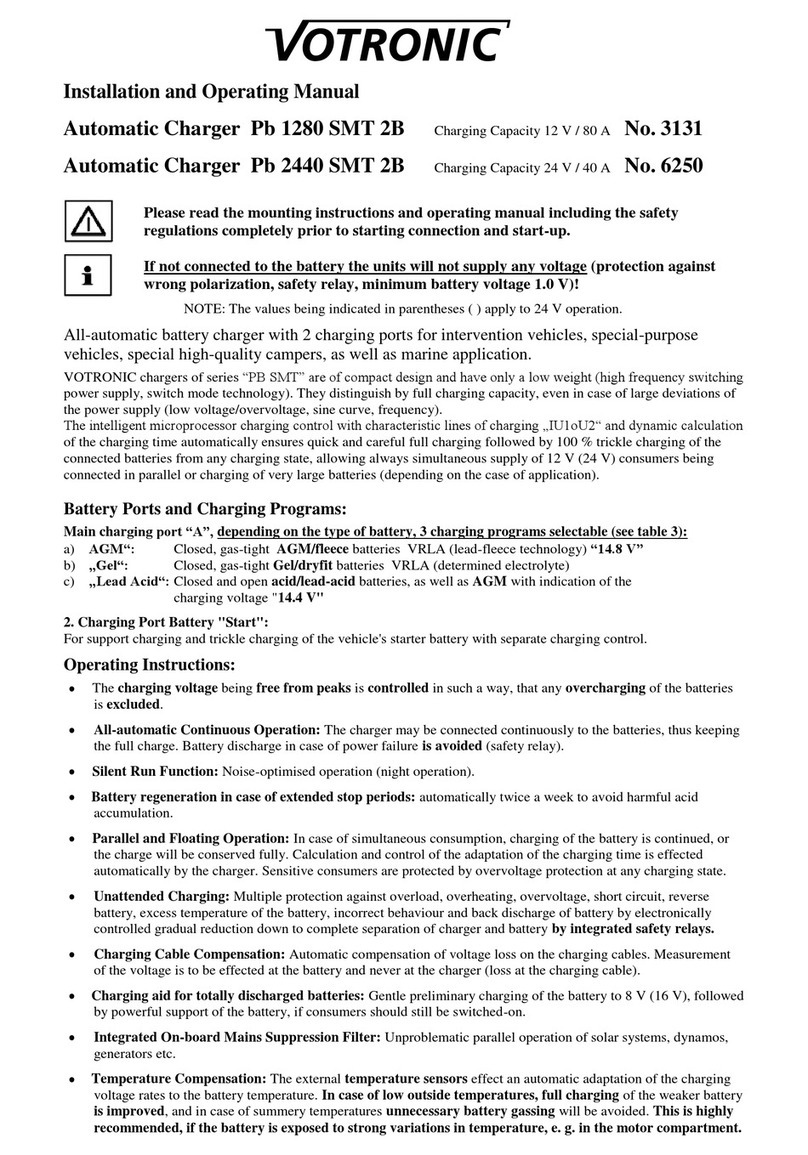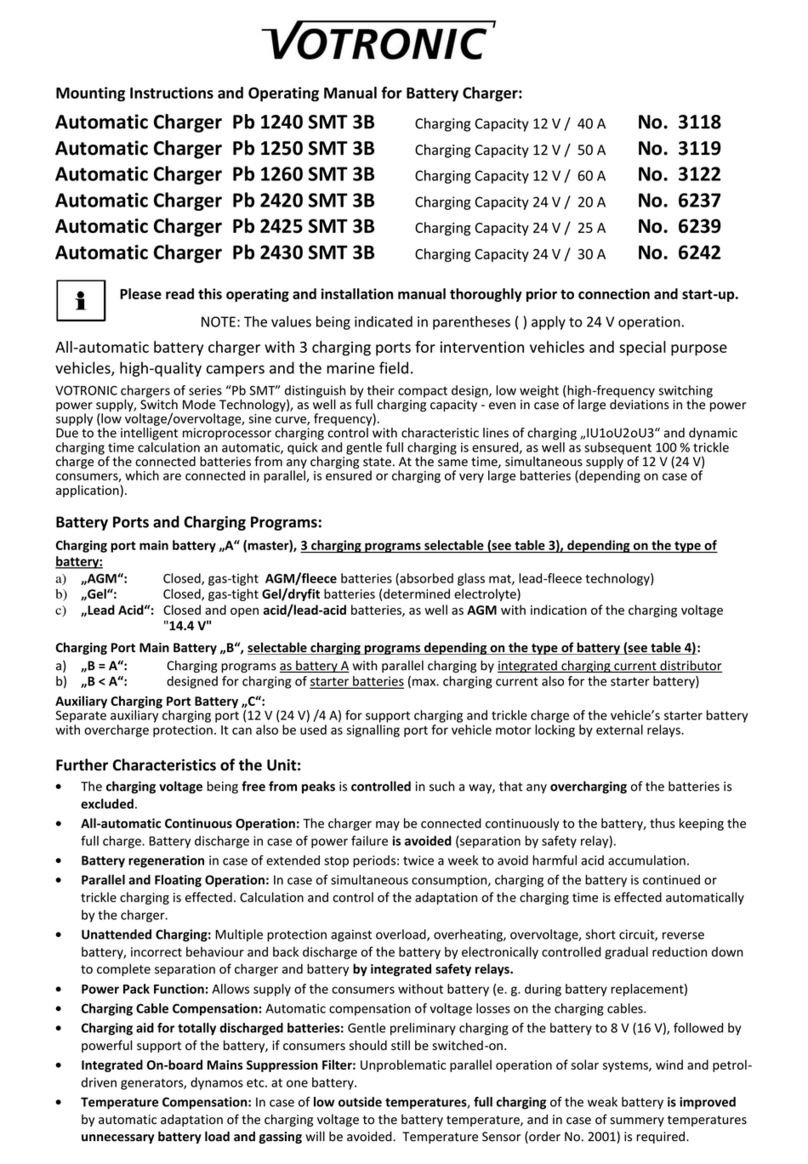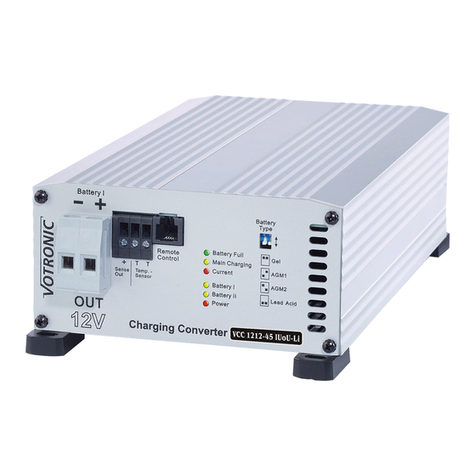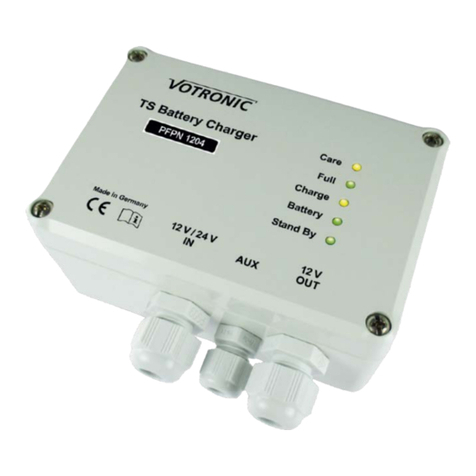
- 5 -
Installation of the Unit:
The charger can be installed near the batteries (short charging cables) at any location being clean and being
protected from humidity and dust.
Despite the charger's high efficiency, heat is produced, which is brought out of the casing by means of the built-in
fan. Ensure sufficient ventilation in the environment of the unit, so that the heat can be carried-off to ensure full
charging capacity. Non-observation will result in gradual reduction (reduced charging capacity).
Protect the unit from aggressive battery gas.
Any position can be chosen for installation, but the vent holes of the casing should never be covered (minimum
distance 10 cm).
Ensure a solid and vibration reducing installation using rubber bushings on an even and hard mounting surface.
Temperature Sensors (Terminals „T T“ I and Terminals „T T“ II ):
The temperature sensors control the battery temperature and the temperature-dependent charging correction.
(Characteristic lines, see also "Temperature Compensation" in this manual.)
Connect the sensor to the corresponding terminals „T T“ of the unit (any polarity).
Never mix up the batteries (I, II)! Absolutely observe the connection plan!
Sensor Installation:
The thermal contact of sensor and battery (inside temperature) should be well. Thus, it should be screwed down
to the negative pole of the battery. It is also possible to fasten it at the sidewall centre of the battery casing.
Ensure that the installation place is not influenced by any source of heat (motor unit, exhaust, heater etc.).
Temperature Compensation:
The temperature-dependent charging voltage of the battery will be adapted automatically to the battery
temperature.
For this, the supplied temperature sensor measures the battery temperature. In case of low temperatures (winter
operation), the charging voltage will be increased in order to improve and accelerate full charging of the weak
battery. Sensitive consumers are protected by a limitation of the voltage in case of very low outside temperatures.
In case of summery temperatures, the charging voltage is reduced to minimize the load (gassing) of the battery
and to extend the lifetime of gas-tight batteries.
Battery Protection (also refer to Characteristic Lines “Charging Voltage Rates and Temperature
Compensation”):
In case of high battery temperatures (depending on type: 54 °C or 58 °C), the charging current will be reduced to
50 % for reasons of safety. If the battery temperature still continues to rise, a complete disconnection will be
effected by the safety relays, as soon as the temperature is exceeded by some °C, the LED „Main Charging“ will be
flashing, but any charging data being recorded hitherto will be kept in memory. Automatic charging will be
resumed as soon as the temperature drops below the above mentioned temperature values. If the battery
temperature drops below -40 °C, the charging process will also be blocked.
The charger recognizes automatically a missing sensor, cable break or short-circuit of the sensor lines,
as well as unreasonable measuring values. In that case, it will switch to the usual charging voltage rates
of 20 °C to 25 °C being recommended by the battery manufacturers.
Option: Battery Voltage Sensor Lines (Terminals „Sense“):
Particularly in case of powerful chargers being equipped with long charging cables, it is recommendable to
measure the battery voltage via a "sensor line" directly at the battery. This allows precise observation of the
charging voltage rates.
Never mix up the batteries (I, II)! Absolutely observe the connection plan!
If several batteries are connected in parallel to a battery system, the „Sense“ line has to be connected to one of
the + poles being connected to each other.
The charger will automatically recognize and evaluate the sensor line(s).
If the sensor line is not installed or in case of a cable break or fuse failures, it will be switched to normal
operation with charging cable compensation (calculated compensation of the voltage losses on the
charging cables).
Option: Vehicle Motor Lock (Terminal "+86"):
If the motor should be started by mistake while the vehicle is still connected to mains, this unit output and a
connected external relay (12 V, max. 0.4 A) in the start circuit can be used to prevent the motor start.
The Terminal "+86" supplies voltage as long as the charger is connected to mains and switched on.



































